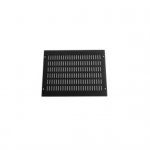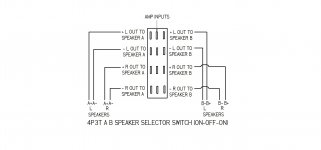I'm ready to order the case for for my Parallel86 and thought I would see what most are using for speaker connections. I looked at all 245 pages and found about 17 builds using binding posts and only 3 or 4 using speakons.
Why the big disparity? I was leaning towards speakons but now wonder, if builders have found binding posts better than speakons, or is it just habit, or going for the look of most hi-end amps?
Why the big disparity? I was leaning towards speakons but now wonder, if builders have found binding posts better than speakons, or is it just habit, or going for the look of most hi-end amps?
Henry,
It's the latter and it's also about "bling bling." Case in point. Me. For my surround speakers I use speakon connectors, nobody looks at them and nobody cares for them. I lock the cable in and it's done.
For my mains, everybody looks at the back of the speaker and my "Cardas" posts have some "bling bling." So everybody oohs and ahhs. Sonically I doubt there is a difference. But the resale value will be higher 😉
Basically...do what you want. The output connector is a infinitesimally small part of the amp building puzzle and we have spent enough time as it is on it. Let's not write another dissertation like we did for solder several pages back.
Best,
Anand.
It's the latter and it's also about "bling bling." Case in point. Me. For my surround speakers I use speakon connectors, nobody looks at them and nobody cares for them. I lock the cable in and it's done.
For my mains, everybody looks at the back of the speaker and my "Cardas" posts have some "bling bling." So everybody oohs and ahhs. Sonically I doubt there is a difference. But the resale value will be higher 😉
Basically...do what you want. The output connector is a infinitesimally small part of the amp building puzzle and we have spent enough time as it is on it. Let's not write another dissertation like we did for solder several pages back.
Best,
Anand.
Basically...do what you want. The output connector is a infinitesimally small part of the amp building puzzle and we have spent enough time as it is on it. Let's not write another dissertation like we did for solder several pages back.
That sums it up nicely. The connectors don't cause any measurable distortion.
People use banana plugs and binding posts because that's what they're comfortable with. As pointed out above, there's a bling factor as well.
The pro world has been using speakON connectors for a long time. The contacts are self-cleaning. They are designed to make a clean connection every time they are plugged in. The 4-pole cable connectors are rated for continuous operation at 40 A RMS (50 A music signal). The chassis connectors come in a 30 A version and a 50 A version (again for the 4-pole).
I use speakON connectors because they are super easy to use. They make a solid connection. They cannot short circuit. They can only be plugged in correctly so no worries about hooking things up in opposite phase. They. Just. Work. This has been evident in the past couple of days as I've been demoing my 4-channel MOD86 amp to the DIY Audio crowd in Victoria, BC as part of the DIY Audio Vancouver Island DIYfest. Everybody can plug in a speakON, but everybody has issues with the gold-plated banana plugs I put on the other end of the speaker cable (to mate with everybody's speakers).
People seem to really enjoy the amp, by the way. It's been tested on some MLTL full rangers and 2-way speakers so far. I suspect some listening impressions will eventually make it onto the meet up thread here: http://www.diyaudio.com/forums/clubs-events/290125-13th-annual-vancouver-island-diyfest-2016-a.html.
Tom
Tom,
Good to know that you're having fun at the diyFEST. It will be interesting to read what the folks have to say about the Mod-86. 🙂
Good to know that you're having fun at the diyFEST. It will be interesting to read what the folks have to say about the Mod-86. 🙂
Thanks all. I don't need the bling. As I mentioned in earlier posts I hide all my equipment. Speakons it is.
Last call for Parallel-86 builders: I have three boards left. Anyone needing a set of boards for a 2.1 system? You can get them here: Parallel-86 (Last Chance to Buy)
Tom
Tom
Attached is my latest layout for my Parallel86 build. It shows a Heatsinkusa 12" profile which will be 4.5" long. It's resistance will be .684 @ C/W/4.5".
I now that's overkill but it will also act as a brace for the aluminum base. I made a separate brace for my Mod86 but now I won't need to.
I am planning to run the wires over the top of the heatsink and can't imagine it would ever get hot enough to damage the wires. All thoughts will be appreciated.
Thanks,
henry
I now that's overkill but it will also act as a brace for the aluminum base. I made a separate brace for my Mod86 but now I won't need to.
I am planning to run the wires over the top of the heatsink and can't imagine it would ever get hot enough to damage the wires. All thoughts will be appreciated.
Thanks,
henry
Attachments
Running the wires over the heat sink should be fine - at least from a temperature standpoint. I’d be a little concerned about chafing as the heat sinks tend to have sharp edges. One could easily address that by milling a channel or groove in the heat sinks, installing a Delrin or Teflon insert and running the wires through that.
You could also run the supply wiring around the heat sink on the right side in your drawing. Maybe move the transformer to the middle and the Power-86 board over to the right to shorten the wire runs.
I do like the idea of letting the heat sink brace the chassis.
Just make sure you have a good number of ventilation holes or slots in the top and bottom plate so you can get good airflow across the heat sink fins.
Tom
You could also run the supply wiring around the heat sink on the right side in your drawing. Maybe move the transformer to the middle and the Power-86 board over to the right to shorten the wire runs.
I do like the idea of letting the heat sink brace the chassis.
Just make sure you have a good number of ventilation holes or slots in the top and bottom plate so you can get good airflow across the heat sink fins.
Tom
Each group of wires will be twisted or bundled and run through pieces of clear teflon tubing I have. Don't feel a need to mill channels or grooves.
Ventilation is no problem. Modushop has the option to get fully ventilated top and bottom aluminum covers instead of almost solid covers. They can be bought as parts or ordered with a chassis. The price is very fair. They have more openings than aluminum. That's why I needed to make a brace for the Mod86 bottom cover and will need one for the Parallel86. See pic.
Ventilation is no problem. Modushop has the option to get fully ventilated top and bottom aluminum covers instead of almost solid covers. They can be bought as parts or ordered with a chassis. The price is very fair. They have more openings than aluminum. That's why I needed to make a brace for the Mod86 bottom cover and will need one for the Parallel86. See pic.
Attachments
Gents' re transformers and PSU. Has anyone experimented with dual and quad secondaries, is there anything to be gained from having a dual-mono psu with separate boards for left and right channels ? I have a 25v, 500VA dual secondary lying around that I'd like to use if there's no loss of quality?
Hi sq225917,
I am pretty sure that Tom will address your question directly, but what I understand that Tom's stellar measurements were obtained using a PSU powered by a single toroidal transformer (and also a +/- 28V SMPS?) - so single toroid should be good for stereo or even 4 channel build, specially with 500VA. IIRC Tom has done a 4 channel build himself with a single transformer.
I am pretty sure that Tom will address your question directly, but what I understand that Tom's stellar measurements were obtained using a PSU powered by a single toroidal transformer (and also a +/- 28V SMPS?) - so single toroid should be good for stereo or even 4 channel build, specially with 500VA. IIRC Tom has done a 4 channel build himself with a single transformer.
Gents' re transformers and PSU. Has anyone experimented with dual and quad secondaries, is there anything to be gained from having a dual-mono psu with separate boards for left and right channels ? I have a 25v, 500VA dual secondary lying around that I'd like to use if there's no loss of quality?
The Modulus-86 is really quite agnostic about its power supply. This comes from its very high power supply rejection ratio (PSRR). I measure the same stellar performance on a regular toroid + Power-86 board; SMPS300RE from Connex; HP 6643A lab supplies. I doubt any dual/quad/octal secondary will give you any different results.
25 V AC will give you ±34-35 V DC when rectified. That's a bit beyond what I recommend for the Modulus-86. It will work, but for new builds I recommend 22 VAC transformers (resulting in about ±30 V DC). That is the best compromise between power dissipation (thermals), output current capability (7 A peak per LM3886), and output power.
±34-35 V would be perfect for the Parallel-86, though. I have three boards left and will have the LM4780s to go with them within the next couple of days.
I sell the Parallel-86 boards with the LM4780 and a piece of SilPad 1500ST for $120/each. If you buy all three boards I will give you 50 % off on the last board. That'll be perfect for anyone needing an amp for a 2.1 system. Once these boards are gone, there will be no more Parallel-86 boards. The Parallel-86 is the best parallel LM3886 amp I've designed to date.
Tom
Just thought I would share my sketch of how, I thought, a toggle could be used as an A B speaker selector switch. As most know I don't know much about electronics. Please let me know if it's wrong?
Looks fine Henry.
Tom
I've been told my schematic is of a 4PDP not a 4P3T. I thought ON OFF ON required a 3T. Back to the research.
If ON-OFF-ON is what you want, then you have the right switch.
A 4P3T switch would be ON-ON-ON, so allow you to select between three sets of speakers.
In switch terminology, beware of brackets. As in ON-(ON), for example. (ON) means momentary. I.e. hold the switch in that position for ON. Let go of the switch and it returns to the other position. A doorbell switch is an SPST OFF-(ON) switch. A basic light switch is SPST OFF-ON.
Tom
A 4P3T switch would be ON-ON-ON, so allow you to select between three sets of speakers.
In switch terminology, beware of brackets. As in ON-(ON), for example. (ON) means momentary. I.e. hold the switch in that position for ON. Let go of the switch and it returns to the other position. A doorbell switch is an SPST OFF-(ON) switch. A basic light switch is SPST OFF-ON.
Tom
- Home
- Amplifiers
- Chip Amps
- Modulus-86 build thread


